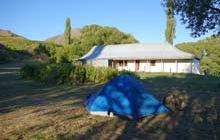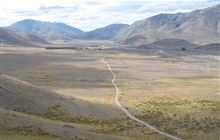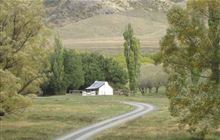History of Rangitahi/Molesworth
Introduction
Rangitahi/Molesworth Recreation Reserve is an iconic high county reserve with rich Māori and farming history. The area is home to the historic Acheron Accommodation House and Molesworth Cob Cottage.The road through Rangitahi/Molesworth was, for a time, the main route from Marlborough and Nelson into Canterbury. Travelers spent weeks at a time crossing its sprawling plains. The paths that follow waterways and valleys have been used by Kāi Tahu since before European settlement.
Image gallery
-
Acheron Accommodation, Molesworth Recreation Reserve Image: Nicholas Hall ©
![Ranger outside Acheron House. Ranger outside Acheron House.]()
-
Shelter at Lake Tennyson Image: Nicholas Hall ©
![Lookout at Molesworth Station. Lookout at Molesworth Station.]()
-
Acheron Road Image: | DOC
![Acheron Road. Acheron Road.]()
-
Molesworth Stream, Molesworth Recreation Reserve Image: Shellie Evans ©
![Molesworth Stream. Molesworth Stream.]()
The historic Acheron Accommodation House and Molesworth Cob Cottage were built in the 1860s, and can still be enjoyed by visitors today. Learn about the history from interpretation panels, camp outside the Cob Cottage, picnic by the Acheron River or walk through the beautiful reserve.
Molesworth is New Zealand’s largest active farm, home to up to 10,000 cattle at one time. The area has been crucial for the development of conservation approaches in New Zealand, through some of the earliest sustained efforts to reduce the impacts of overstocking, rabbits and erosion on the fragile high-country landscape.
Getting there
Between Labour weekend and early April, you can drive through Rangitahi/Molesworth Recreation Reserve on the Acheron Road. Be aware that the road can close during this period and check this website for updates and information about road conditions before visiting.
Early trail blazing
Kāi Tahu referred to the area later known as Molesworth as Rangitahi, meaning "converging skies". The routes described to early European settlers were pioneered by Kāi Tahu, who visited the area every 3-5 years to collect food and access the sacred pounamu/jade on the west coast.
Routes of industry
With the establishment of farming in the early 1850s, European settlers drove stock through the reserve in trips that would often take weeks. The discovery of gold in the South Island in the 1860s saw the numbers of travellers through Molesworth explode. The Acheron Accommodation House, also known as the Clarence Accommodation House, was built in 1863.
Community legacy
From the 1860s to the 1930s, the Acheron house was a centre of social activity, an unofficial post office, and local store. The historic Molesworth Cob Cottage was built in 1866 using ingenious cob building techniques, where earth and tussock were packed into sturdy bricks and used to structure the house in the absence of timber. The current farm is the combination of four separate runs in the area and remains an iconic piece of South Island history.
Interpretation panels
Iinterpretation panels located on Molesworth tell stories of the area.








